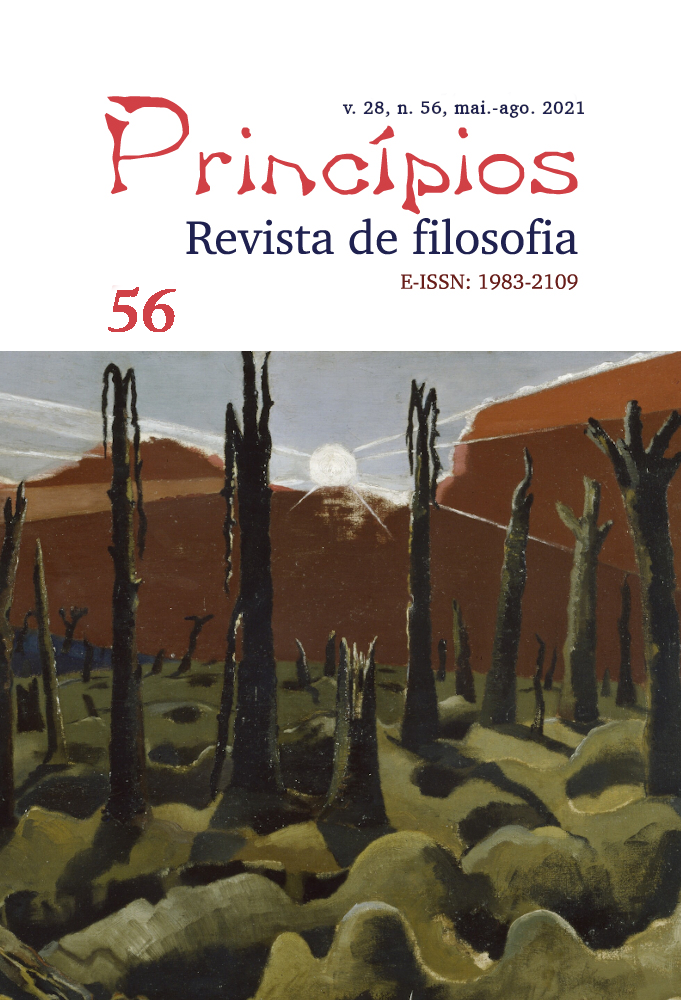English
DOI:
https://doi.org/10.21680/1983-2109.2021v28n56ID23120Keywords:
Objetos Ficcionais, Objetos Abstratos, Artefatos, Atos de Fala, PerformativosAbstract
I answer in this paper to Stuart Brock’s (2010, 2016) main objection to artifactualism. According to Brock, artifactualists like Amie Thomasson (1999) can’t explain how and when fictional objects are created, thus taking artifactualism as a sort of theological creationism. Contrary to Brock, and adapting John Austin’s (1962) speech act theory to this case, I argue that fictional objects are created through a performative utterance that, in order to be felicitous, has to be (i) made by an adequate individual (an author), (ii) with the proper intentions (the act of fiction-making), (iii) in an appropriate context (associated with our pre-established practices of fiction) where the author (iv) names, gives at least a description or provides an image in order to institute the individual object through his or her intentional acts.
Downloads
References
ABELL, Catharine. Fiction: A Philosophical Analysis. Oxford: Oxford University Press, 2020
AUSTIN, John. How to Do Things with Words: The William James Lectures. Oxford: Clarendon Press, 1962.
BERTO, Francesco. Modal Meinongianism and Fiction: The Best of Three Worlds. In. Philosophical Studies, v. 152, n.3, pp. 313-335, 2011.
BRASIL. Código Civil, Lei 10.406, de 10 de janeiro de 2002. São Paulo: Revista dos Tribunais, 2002.
BROCK, Stuart. Fictionalism about Fictional Characters Revisited. In. Res Philosophica, v. 93, n. 2, pp. 377-403, 2016.
BROCK, Stuart. The Creationist Fiction: The Case Against Creationism about Fictional Characters. In. Philosophical Review, v. 119, n. 3, pp. 337-364, 2010.
CARROLL, Noel. The Wheel of Virtue: Art, Literature, and Moral Knowledge. In. The Journal of Aesthetics and Art Criticism, v. 60, n. 1, pp. 3-26, 2002.
CURRIE, Gregory. The Nature of Fiction. Cambridge: Cambridge University Press, 1990.
EVERETT, Anthony. The Nonexistent. Oxford: Oxford University Press, 2013.
GIBSON, John. Interpreting Words, Interpreting Worlds. In. The Journal of Aesthetics and Art Criticism, v. 64, n. 4, pp. 439-450, 2006.
INGARDEN, Roman. The Literary Work of Art: An Investigation on the Borderlines of Ontology, Logic, and Theory of Literature. Evanston: Northwestern University Press, 1973.
INWAGEN, Peter van. Fiction and Metaphysics. In. Philosophy and Literature, v. 7, n. 1, pp. 67-77, 1983.
INWAGEN, Peter van. Creatures of Fiction. In. American Philosophical Quarterly, v. 14, n. 4, pp. 299-208, 1977.
KAFKA, Franz. The Metamorphosis. Translated by Susan Bernofsky. New York: W. W. Norton & Company, 2014.
KIVY, Peter. Philosophies of Arts: An Essay in Differences. Cambridge: Cambridge University Press, 1997.
(Author omitted due to blind-review, 2020a)
(Author omitted due to blind-review, 2020b)
(Author omitted due to blind-review, 2020c)
SAINSBURY, Mark. Fiction and Fictionalism. London: Routledge, 2009.
SCHIFFER, Stephen. The Things we Mean. Oxford: Oxford University Press, 2003.
SCHIFFER, Stephen. Language-Created Language-Independent Entities. In. Philosophical Topics, v. 24, n. 1, pp. 149-167, 1996.
SEARLE, John. The Construction of Social Reality. New York: Penguin Books, 1995.
SEARLE, John. The Logical Status of Fictional Discourse. In. New Literary History, v. 6, n. 2, 1975.
STOCK, Kathleen. Only Imagine: Fiction, Interpretation and Imagination. Oxford: Oxford University Press, 2017.
THOMAS, Jenny. Meaning in Interaction: An Introduction to Pragmatics. New York: Routledge, 1995.
THOMASSON, Amie. Speaking of Fictional Characters. In. Dialectica, v. 57, n. 2, pp. 207-26, 2003.
THOMASSON, Amie. Fiction and Metaphysics. Cambridge: Cambridge University Press, 1999.
WITTGENSTEIN, Ludwig. Philosophical Investigations. Translated by G. E. M. Anscombe. Oxford: Basil Blackwell, 1953.
Downloads
Published
How to Cite
Issue
Section
License
Authors retain copyright and grant the journal right of first publication with the work simultaneously licensed under a Creative Commons Attribution License that allows others to share the work with an acknowledgement of the work's authorship and initial publication in this journal.


 Português (Brasil)
Português (Brasil) English
English Español (España)
Español (España) Français (Canada)
Français (Canada)


